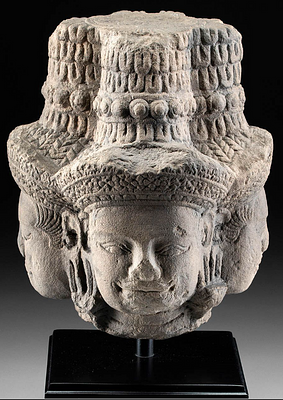19th C. Indo-Persian Erotic Folio Page Div Demon
Lot 65a
About Seller
Artemis Gallery
686 S Taylor Ave, Ste 106
Louisville, CO 80027
United States
Selling antiquities, ancient and ethnographic art online since 1993, Artemis Gallery specializes in Classical Antiquities (Egyptian, Greek, Roman, Near Eastern), Asian, Pre-Columbian, African / Tribal / Oceanographic art. Our extensive inventory includes pottery, stone, metal, wood, glass and textil...Read more
Categories
Estimate:
$1,600 - $2,400
Absentee vs Live bid
Two ways to bid:
- Leave a max absentee bid and the platform will bid on your behalf up to your maximum bid during the live auction.
- Bid live during the auction and your bids will be submitted real-time to the auctioneer.
Bid Increments
| Price | Bid Increment |
|---|---|
| $0 | $25 |
| $300 | $50 |
| $1,000 | $100 |
| $2,000 | $250 |
| $5,000 | $500 |
| $10,000 | $1,000 |
| $20,000 | $2,500 |
| $50,000 | $5,000 |
| $100,000 | $10,000 |
| $200,000 | $20,000 |
About Auction
By Artemis Gallery
Jun 29, 2023
Set Reminder
2023-06-29 10:00:00
2023-06-29 10:00:00
America/New_York
Bidsquare
Bidsquare : Exceptional Antiquities, Ethnographic and Fine Art
https://www.bidsquare.com/auctions/artemis-gallery/exceptional-antiquities-ethnographic-and-fine-art-13031
Artemis Gallery info@artemisgallery.com
Artemis Gallery info@artemisgallery.com
- Lot Description
Central Asia, Persia & India, Islamic & Mughal culture, ca. late 19th to early 20th C. An illuminated folio page of an erotic demon, painted in opaque gouache pigments on paper. The calligraphy is written in two columns on the verso, with marks in the margins around the painting and in a border above the demon. This demon is known as a div (dev) stemming from ancient Persian demons that made their way into Islamic beliefs and were evil and some had magical powers. Divs had monstrous human bodies with horns and tusk like teeth, as seen here. The nude female div is being sexually pleasured by winged phalluses, a bizarre erotic scene. Size of paper: 8.25" L x 5.8" W (21 cm x 14.7 cm); illustration: 6.25" L x 4" W (15.9 cm x 10.2 cm)
Before Islamic and British European colonialism, Indian gods, goddesses, and mortals, were openly portrayed celebrating life’s pleasures and of course the most famous ancient text on sex, the "Vatsyayana Kamasutram," better known as the "Kama Sutra," was written in India. During the 19th and early 20th century, demons were the ones most often openly illustrated engaging in sexual activities as a correlation between evil, grotesque beings conducting themselves in what was deemed shameful, lurid acts by Western cultures.
Miniature painting emerged in Persian art during the 13th century. Following the Mongol conquests, the genre displayed strong Chinese influence, and the tradition reached its peak during the 15th and 16th centuries. Persian miniature painting influenced other Islamic miniature traditions, including the Ottoman miniature created in Turkey as well as the Mughal miniature of India. Interestingly, Persian art - although under the influence of Islam - never completely forbade the inclusion of the human figures. Scholars believe that this was because the miniature was used as a private form of visual culture. These images were usually kept in a book or an album and only shown to a select audience, for this reason, artists could be more free when creating miniatures…
Provenance: Ex-Denenberg Fine Arts, Los Angeles, California USA
All items legal to buy/sell under U.S. Statute covering cultural patrimony Code 2600, CHAPTER 14, and are guaranteed to be as described or your money back.
A Certificate of Authenticity will accompany all winning bids.
We ship worldwide and handle all shipping in-house for your convenience.
#178973Page is taken from a larger text. Some foxing and discoloration from age, stain to lower center edge of illustration. Smudging and rubbing to ink text columns on verso, and some script is now indiscernible although most is intact.Condition
- Shipping Info
-
All shipping is handled in-house for your convenience. Your invoice from Artemis Gallery will include shipping calculation instructions. If in doubt, please inquire BEFORE bidding for estimated shipping costs for individual items.
-
- Buyer's Premium



 EUR
EUR CAD
CAD AUD
AUD GBP
GBP MXN
MXN HKD
HKD CNY
CNY MYR
MYR SEK
SEK SGD
SGD CHF
CHF THB
THB












